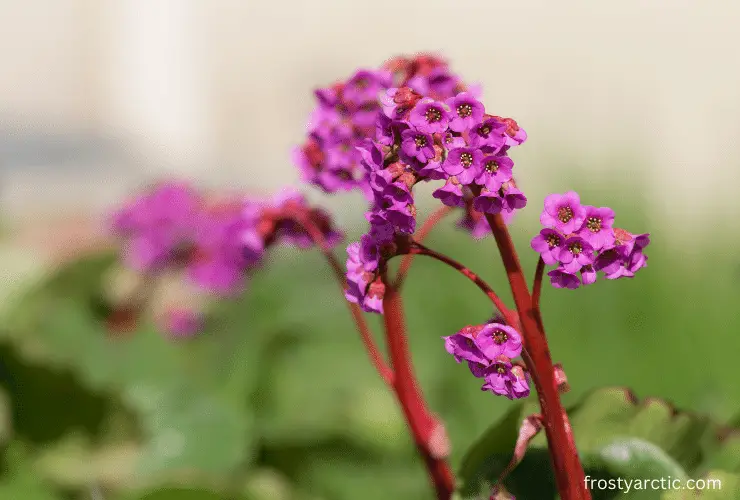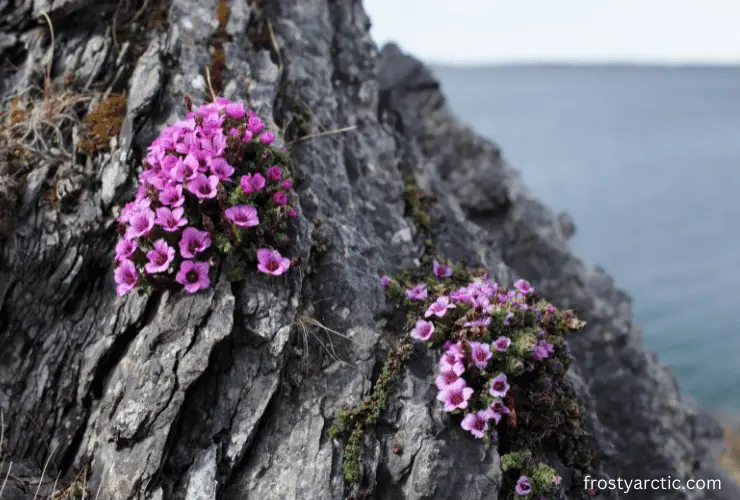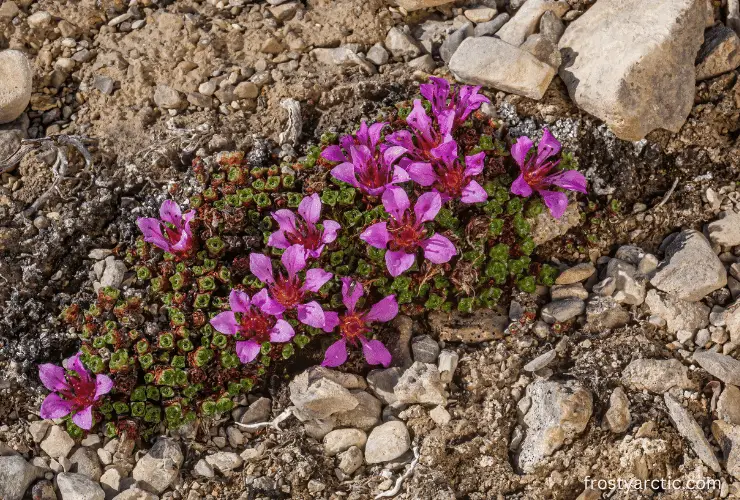Purple saxifrage is an eye-catching, colorful, and low-growing plant. This plant can survive the harsh climate of the Arctic regions due to its specialized adaptations. Besides, this plant has excellent nutritional and herbal values, and that’s why people use it for medicinal purposes.
You might have heard fascinating facts about the purple saxifrage. Today, I will enlighten you about its characteristics, growing habits, and uses here. You will also come to know if this plant is safe to eat or not. Thus, without further ado, let’s dive into the main discussion.
Purple Saxifrage at A Glance [Saxifraga Oppositifolia]
| Parameters | Details |
| Scientific name | Saxifraga oppositifolia |
| Plant type | Perennial |
| Height | 2-5 cm |
| Width | 12-15 cm |
| Leaf color | Grayish- green |
| Leaf size | 2mm-4mm |
| Flower color | Purple, magenta, and white |
| Flower size | 1-1.5 cm |
| Fragrance | Mild |
| Blooming season | Spring, summer, or fall winter |
| Sun exposure | Partial sun |
| Water needs | Low to moderate |
| Soil type | Sand, loam, well-drained |
| Soil pH | Neutral to alkaline |
| Uses | Food source for arctic animals and Inuit people, Medicinal uses |
What Is Purple Saxifrage?
Purple saxifrage is one kind of flowering plant which blooms early in the summer. The scientific name of purple saxifrage is Saxifraga oppositifolia which belongs to the family Saxifragaceae.
Purple saxifrage is a low-growing and mat-forming evergreen perennial plant. It can reach up to 5 cm high. The short stem of this plant is entirely covered with its leaves. Surprisingly, the size of those leaves is small, between 2mm-4mm. Those tiny leaves are grayish green in color, overlapping, and have four rank arrangements.

From the name, you can already guess that the color of the flowers of this plant is purple. Somewhere, you can also find white flowers of this plant. However, the flower size is almost 1-1.5 cm which is relatively more significant than the leaves.
This herb looks most elegant and impresses when the flower blooms. On those south-facing slopes, you can find the flower blooming in the early spring. But, in north-facing ridges, you can’t notice any sign of flower blooming until mid-July arrives.
Why Is It Called Purple Saxifrage?
This plant is called purple saxifrage for its color and growing place. The word “Saxifrage” refers to “rock breakers” in Latin.
Purple saxifrage has beautiful star-shaped flowers of purple color. They are mainly eye-catching for those dark purple color flowers.
Besides, you can also find them growing out from the crack or split between the rocks. Even while hiking, you may find them on the concave surface of stones.
This plant’s root can literally go through the rock’s surface. Therefore, they can absorb water and nutrients beneath those rocks.
Where Does Purple Saxifrage Grow?
Purple saxifrage generally grows well in calcium-rich soil. They can even grow in rocky, barren fields.
Native habitats of purple saxifrage are the high-arctic, the alps, northern Britain, and the high and stony mountains. You can find them to grow well in partial shade.
Their growth rate becomes slow in full sun or full shade. If you want to plant this flowering plant, ensure that the soil is neutral to alkaline. Otherwise, the plant may die.
Besides, purple saxifrage needs adequate water for growth. That’s why the soil of the ground that you select for planting them should be moist. However, if the water is not well-drained, it may rot the root of the plant.
Is Purple Saxifrage A Producer?
Yes. Purple saxifrage is a bottom-line producer of the food chain. Other primary and secondary consumers rely on them directly and indirectly, respectively, for food.
Do you know what it means to be the producer of an ecosystem? Producers are those organisms in the sun that produce their food through photosynthesis.
The photosynthesis process occurs inside the plastid of the grayish-green leaves of purple saxifrage. Primary consumers rely on these plants, and secondary consumers depend on primary consumers.
Purple Saxifrage Adaptations

Purple saxifrage can grow in both cold water and rocky ground. This plant evolved a lot to adapt to the climate of its habitats. Those adaptations are
- Low growing: This plant grows low near the ground. Thus, risk and damage due to abrasion of wind get lower.
- Small leaves: The evaporation and transpiration rates also decline due to small leaves. This protects them from dehydration.
- Rigid hair on leaves: This adaption protects them against the wind. Mainly, those hairs compile the snow on the plant’s body until it forms a tiny snowball. These snowballs block the wind from harming the purple saxifrage.
- Evergreen leaves: Purple saxifrage typically has a short growing season. In this case, their evergreen nature helps them to use leaves as soon as winter starts to disappear.
- Flecks of calcium carbonate: As this plant grows in a calciferous soul, it is covered with a layer of calcium carbonate. This layer ensures to protect them from harmful radiations and UV rays.
- Longer flower period: This plant flowers for almost two weeks. Thus, fewer numbers of pollinators of this plant get enough time for pollination.
- Sticky stems: Stems of this plant are pretty sticky, which is capable of blocking insects except for pollinators. Thus, only pollinators have access to the nectar of this flowering plant.
How Does Purple Saxifrage Survive in The Arctic?
Purple saxifrage has specialized adaptation to cope with the adverse weather of the arctic region. That’s why they can survive there well.
Arctic regions are northern polar cold regions. Purple saxifrage has tiny leaves with rigid hair to survive in this cold weather. These features help them retain their moisture and protect them from drying in the hard winter.
Also, those stiff hairs reduce the intensity of the wind, so that purple saxifrage can survive without breaking in the strong wind.
Purple Saxifrage Species: Let’s Talk About
Saxifraga oppositifolia belongs to the genus Saxifraga. There are almost 400 species in this genus. Among them, the species oppositifolia of this genus is known as purple saxifrage.
There are also several subspecies of this species. However, you can find some of those subspecies in only some particular regions.
Here’s a table mentioning some of the popular subspecies of the Purple Saxifraga:
| Subspecies of Purple Saxifraga | Natural habitat |
| Saxifraga oppositifolia ssp. smalliana | Alaska, Yokon |
| Saxifraga oppositifolia ssp. glandulisepala | Alaska |
| Saxifraga oppositifolia ssp. oppositifolia | Continental US |
| Saxifraga oppositifolia ssp. speciosa | Italy |
| Saxifraga oppositifolia ssp. rudolphiana | Eastern Alps, East, and south Carpathians |
| Saxifraga oppositifolia ssp. paradoxa | Pyrenees |
| Saxifraga oppositifolia ssp. murithiana | Spain, Alps, Pyrenees |
| Saxifraga oppositifolia ssp. latina | Central Italy |
| Saxifraga oppositifolia ssp. blepharophylla | North-East Alps |
| Saxifraga oppositifolia ssp. amphibia | Central Europe |
| Saxifraga oppositifolia ssp. ajanica | Central Russian far east, Eastern Siberia |
All these subspecies are known as purple mountain Saxifraga. They are mainly found in subarctic and subalpine regions.
Purple Saxifrage Taste
Purple saxifrage tastes sweet. Generally, people eat this flower when fruits like berries are inadequate.

The first question that may arise in your mind is, ” is purple saxifrage edible?” Yes, the flower petals of purple saxifrage are edible. You will feel a sweet taste in your mouth if you consume those flower petals. Sometimes, you might find it bitter at first, but within one or two seconds, it will start tasting sweet.
However, though it’s edible and tastes sweet, you shouldn’t eat this flower too much. If you eat purple saxifrage flowers in an excessive amount, you will start to feel unwell, stomach pain, cramps, and diarrhea. Therefore, make sure you are eating it in a moderate amount.
What Is the Purple Saxifrage Plant Used For?
This purple saxifrage plant has a broad range of uses. Some of them are:
- Making dye: Purple saxifrage is one of the most colorful plants on the earth. That is why people use this plant a lot to make different types of dye. Mainly, people produce yellow, green, and creamy dyes using other parts of these plants.
- Nutrition: Purple saxifrage plant can be an excellent source of nutrition. The flower of this plant contains vitamin C, and the stems and leaves have many herbal qualities and also contain anthocyanins.
- Beverage: People in many places also use this plant in drinks to enrich the nutritional quality and sweet taste.
- Alternative to Berries: In some places of the world, you won’t get berries in an abundant amount. In this case, the price of berries is also high in those regions. That’s why people in those areas eat the sweet flower petals of this plant as an alternative to berries.
- Scientific study: Scientists use this plant for conducting their research on the climate change effects on the arctic plants. This plant can be well-adapted to the arctic climate. But a slight change in the weather harms the growth and reproduction of this plant. That is why scientists and researchers take this plant as a subject for conducting their research.
What Animals Eat Purple Saxifrage?
Mainly several arctic animals eat this purple saxifrage. This plant is well-adapted to arctic weather and can’t grow well anywhere other than the arctic region. That’s why its predator list only consists of arctic creatures.

Arctic hares and ground squirrels are very fond of this flower. You might find them enjoying eating this plant. Besides, multiple types of caterpillars are also on their predator list.
Typically, these caterpillars also adapted themselves to the harsh cold weather. Some wolly-polar- bear caterpillars and cold-adapted caterpillars consume this plant’s flower for survival.
What Did Native Americans Use Purple Saxifrage For?
Purple saxifrage is quite popular among native Americans. They use the plant for various purposes. Some of them are:
- Tea: Native American brew the stems and leaves of this plant to make herbal tea. Mainly, they collect those leaves or stems after flowers die. The reason is the tea tastes better in this way. Not only does this tea taste better, but it also has more health benefits.
- Tobacco: As tobacco is very pricey, Native Americans are used to mixing the stem and leaves of this plant with the tobacco. The reason is this plant contains much more anthocyanin than any other wild tobacco, such as tobacco corolla. Generally, they use the stem and smoke them within a pipe.
- Timekeeping function: Native American use this flowering plant as a timekeeping function. Near the early spring, Caribou start to give birth to their young. This time is also the blooming time of purple saxifrage. That’s why when native Americans see this flower blooming; they understand that the birthing time of caribou calves is near.
- Source of vitamin C: This flower is an excellent source of vitamin C and tastes sweet. Native Americans eat flower petals to meet their Vitamin C needs in the body.
Is Purple Saxifrage a Medicinal Plant? Medicinal Uses Of Purple Saxifrage
Yes. Purple saxifrage is a medicinal plant. Mainly, Inuit people use this plant a lot to make several herbal remedies. Here are some therapeutic benefits of this plant:
- Gastrointestinal Problems
Purple saxifrage can reduce gastrointestinal problems. The tea leaves of these plants have high herb benefits that reduce gastric issues.
This tea helps digestion, and thus the bloating and burping get reduced. It is also beneficial in reducing stomach acids and digestive enzymes, which reduce the troubles in digestion.
- Stomach aches
There are two reasons for stomach aches, one is an inflammatory disease, and the other is a stomach infection. This plant contains both anti-microbial and anti-inflammatory properties. Therefore, with the help of these properties, purple saxifrage reduces stomach aches. The fiber of this plant also helps to relieve stomach aches.
- Urinary calculi
Due to the presence of potassium in purple saxifrage, it helps to treat urinary calculi by reducing kidney stones. This plant serves some ingredients which can break down the rocks of the kidney.
FAQs
Why is the purple saxifrage Nunavut flower?
This flower plays an influential role in Northern culture. It has various uses like tea, tobacco, berries, etc. That’s why it became the most reliable plant in Nunavut; even people choose it as a floral emblem. Thus, it is known as the Nunavut flower.
Do Saxifraga come back every year?
Yes. Saxifraga comes back every year. This plant is one of the perennial plants of the arctic region. That means it has extended-lasting longevity, and flowers keep blooming every year on time.
Can saxifrage survive frost?
Yes, saxifrage can survive frost. When it gets covered in snow and frost, the growth becomes gradual. As soon as the winter and snow cover starts to disappear, the flower starts blooming.
Will saxifrage grow in pots?
Yes. Saxifrage can grow in pots. But, you have to make sure the conditions are almost similar to the Arctic soil condition. Ensure that there is no standing water in the pot. If the root doesn’t get enough oxygen to thrive due to water, it will die.
How does the purple saxifrage reproduce?
Purple saxifrage reproduces through self-fertilization and cross-fertilization. In cross-fertilization, pollinators help the pollination process from one flower to another. However, the self-pollination process produces fewer seeds and doesn’t result in genetic variations.
Conclusion
Purple saxifrage is a wild flowering plant. That’s why people are always fascinated and curious about this beautiful plant. Some people may fear consuming this plant. But this plant is edible and also has a lot of health benefits. Still, if you eat this plant excessively, you will feel unwell.



6 thoughts on “Purple Saxifrage: Common Plant in the Arctic Region”